Comprehensive Guide: How to Use NumPy to Zero an Axis in Arrays
NumPy how to zeros an axis is a crucial concept in data manipulation and preprocessing. This article will delve deep into the various methods and techniques to zero out specific axes in NumPy arrays. We’ll explore the fundamentals, advanced techniques, and practical applications of zeroing axes in NumPy, providing you with a comprehensive understanding of this essential operation.
Understanding NumPy Arrays and Axes
Before we dive into how to zero an axis in NumPy, let’s first understand what NumPy arrays and axes are. NumPy is a powerful library for numerical computing in Python, and its core data structure is the ndarray (n-dimensional array). An axis in NumPy refers to a specific dimension of the array.
To illustrate this, let’s create a simple 2D NumPy array:
import numpy as np
arr = np.array([[1, 2, 3],
[4, 5, 6],
[7, 8, 9]])
print("Array shape:", arr.shape)
print("Array:\n", arr)
Output:
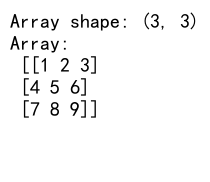
In this example, we create a 2D array with shape (3, 3). The first axis (axis 0) represents the rows, and the second axis (axis 1) represents the columns.
Basic Methods to Zero an Axis in NumPy
Now that we understand the concept of axes in NumPy arrays, let’s explore the basic methods to zero out a specific axis. The most straightforward approach is to use array indexing and assignment.
Zeroing a Row (Axis 0)
To zero out a specific row (axis 0) in a NumPy array, we can use integer indexing:
import numpy as np
arr = np.array([[1, 2, 3],
[4, 5, 6],
[7, 8, 9]])
arr[1] = 0 # Zero out the second row
print("Array after zeroing second row:\n", arr)
Output:
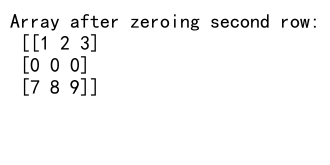
In this example, we zero out the second row (index 1) of the array. The arr[1] = 0 operation assigns zero to all elements in the specified row.
Zeroing a Column (Axis 1)
To zero out a specific column (axis 1), we can use slice indexing:
import numpy as np
arr = np.array([[1, 2, 3],
[4, 5, 6],
[7, 8, 9]])
arr[:, 1] = 0 # Zero out the second column
print("Array after zeroing second column:\n", arr)
Output:
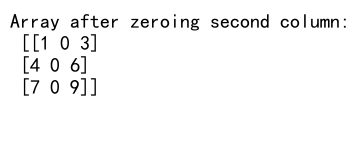
Here, we use arr[:, 1] = 0 to zero out the second column (index 1) of the array. The colon : selects all rows, and 1 selects the second column.
Advanced Techniques for Zeroing Axes in NumPy
While the basic methods are useful for simple cases, NumPy provides more advanced techniques for zeroing axes in arrays. These methods offer greater flexibility and efficiency, especially when dealing with larger and more complex arrays.
Using np.zeros_like() to Zero an Axis
The np.zeros_like() function creates an array of zeros with the same shape and data type as the input array. We can use this in combination with array indexing to zero out specific axes:
import numpy as np
arr = np.array([[1, 2, 3],
[4, 5, 6],
[7, 8, 9]])
zeros = np.zeros_like(arr[0])
arr[1] = zeros # Zero out the second row
print("Array after zeroing second row:\n", arr)
Output:
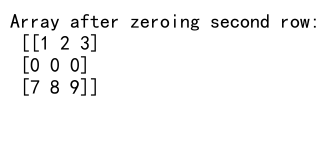
This method is particularly useful when you want to maintain the data type of the original array.
Using np.where() to Conditionally Zero an Axis
The np.where() function allows us to conditionally zero out elements based on a given condition. This is useful when you want to zero out an axis based on certain criteria:
import numpy as np
arr = np.array([[1, 2, 3],
[4, 5, 6],
[7, 8, 9]])
condition = np.arange(arr.shape[1]) == 1 # Condition to zero out second column
arr = np.where(condition, 0, arr)
print("Array after conditionally zeroing second column:\n", arr)
Output:

In this example, we create a condition that is True for the second column and False elsewhere. The np.where() function then replaces the values where the condition is True with 0, effectively zeroing out the second column.
Zeroing Multiple Axes Simultaneously
In some cases, you might need to zero out multiple axes at once. NumPy provides several ways to accomplish this efficiently.
Using Boolean Indexing to Zero Multiple Axes
Boolean indexing is a powerful technique that allows us to zero out multiple axes based on complex conditions:
import numpy as np
arr = np.array([[1, 2, 3],
[4, 5, 6],
[7, 8, 9]])
mask = np.zeros_like(arr, dtype=bool)
mask[0, :] = True # Zero out first row
mask[:, 2] = True # Zero out third column
arr[mask] = 0
print("Array after zeroing first row and third column:\n", arr)
Output:
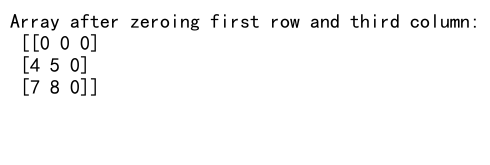
In this example, we create a boolean mask with the same shape as our array. We set the elements corresponding to the first row and third column to True, then use this mask to zero out those elements in the original array.
Using np.put() to Zero Multiple Elements
The np.put() function allows us to modify multiple elements of an array at once:
import numpy as np
arr = np.array([[1, 2, 3],
[4, 5, 6],
[7, 8, 9]])
indices = np.array([0, 4, 8]) # Indices of elements to zero out
np.put(arr, indices, 0)
print("Array after zeroing specific elements:\n", arr)
Output:

This method is particularly useful when you want to zero out specific elements across different axes.
Zeroing Axes in Higher Dimensional Arrays
While we’ve primarily focused on 2D arrays so far, NumPy can handle arrays of any dimension. Let’s explore how to zero axes in higher dimensional arrays.
Zeroing a Plane in a 3D Array
In a 3D array, we might want to zero out an entire plane:
import numpy as np
arr = np.arange(27).reshape(3, 3, 3)
arr[:, 1, :] = 0 # Zero out the middle plane
print("3D array after zeroing middle plane:\n", arr)
Output:
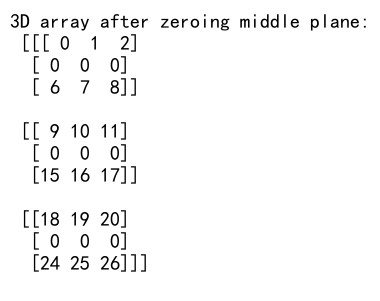
In this example, we create a 3D array and zero out the middle plane (index 1 of the second axis).
Zeroing Multiple Axes in a 4D Array
For even higher dimensional arrays, we can combine multiple indexing techniques:
import numpy as np
arr = np.arange(81).reshape(3, 3, 3, 3)
arr[1, :, :, 2] = 0 # Zero out a specific "slice" of the 4D array
print("4D array after zeroing a specific slice:\n", arr)
Output:
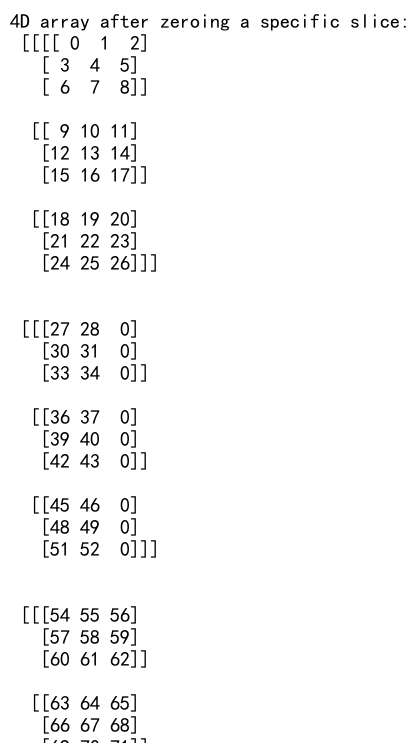
This example demonstrates zeroing out a specific “slice” of a 4D array, showcasing the flexibility of NumPy’s indexing capabilities.
Efficient Methods for Zeroing Large Arrays
When dealing with large arrays, efficiency becomes crucial. NumPy provides several methods to zero out axes in large arrays efficiently.
Using np.zeros() with Array Assignment
For large arrays, creating a separate array of zeros and assigning it can be more efficient:
import numpy as np
arr = np.random.rand(1000, 1000) # Large 2D array
zeros = np.zeros(arr.shape[1])
arr[500:600] = zeros # Zero out rows 500-599
print("Shape of array after zeroing rows 500-599:", arr.shape)
Output:

This method is particularly efficient for large arrays as it avoids creating unnecessary temporary arrays.
Using np.fill() for In-Place Zeroing
The np.fill() method allows for in-place modification of arrays, which can be more memory-efficient:
import numpy as np
arr = np.random.rand(1000, 1000) # Large 2D array
arr[:, 250:500].fill(0) # Zero out columns 250-499
print("Shape of array after zeroing columns 250-499:", arr.shape)
Output:

This method is useful when you want to zero out a large portion of an array without creating any temporary arrays.
Practical Applications of Zeroing Axes in NumPy
Understanding how to zero axes in NumPy arrays is not just a theoretical exercise; it has numerous practical applications in data science and scientific computing.
Data Preprocessing
In data preprocessing, zeroing out certain features or samples can be crucial:
import numpy as np
data = np.random.rand(100, 5) # 100 samples, 5 features
data[:, 2] = 0 # Zero out the third feature for all samples
print("Shape of data after zeroing third feature:", data.shape)
Output:

This example demonstrates how you might zero out a specific feature across all samples in a dataset.
Image Processing
In image processing, zeroing out certain regions of an image can be useful for various tasks:
import numpy as np
image = np.random.rand(100, 100, 3) # RGB image
image[25:75, 25:75, :] = 0 # Zero out a square region in the center
print("Shape of image after zeroing center region:", image.shape)
Output:

This example shows how to zero out a square region in the center of an image, which could be useful for creating masks or focusing on specific areas.
Advanced Techniques and Considerations
As we delve deeper into the world of NumPy and zeroing axes, there are some advanced techniques and considerations to keep in mind.
Using np.einsum() for Complex Zeroing Operations
For more complex zeroing operations, especially in higher dimensional arrays, np.einsum() can be a powerful tool:
import numpy as np
arr = np.random.rand(4, 4, 4)
indices = np.array([0, 2])
result = np.einsum('ijk,i->ijk', arr, np.ones(arr.shape[0]))
result[indices] = 0
print("Shape of array after complex zeroing operation:", result.shape)
Output:

This example uses np.einsum() to perform a complex zeroing operation on specific indices of a 3D array.
Memory Considerations when Zeroing Large Arrays
When working with very large arrays, memory usage becomes a critical consideration. In-place operations can help minimize memory usage:
import numpy as np
arr = np.random.rand(10000, 10000) # Very large 2D array
arr.flat[::2] = 0 # Zero out every other element in-place
print("Shape of array after in-place zeroing:", arr.shape)
Output:

This example uses the flat attribute to efficiently zero out every other element in a very large array without creating any temporary arrays.
Handling Special Cases
There are some special cases to consider when zeroing axes in NumPy arrays.
Handling NaN Values when Zeroing
When dealing with arrays that contain NaN values, special care must be taken:
import numpy as np
arr = np.array([[1, np.nan, 3],
[4, 5, np.nan],
[7, 8, 9]])
arr[np.isnan(arr)] = 0 # Replace NaN values with 0
print("Array after replacing NaN values with 0:\n", arr)
Output:

This example shows how to replace NaN values with zeros before performing any zeroing operations.
Best Practices and Performance Tips
To wrap up our comprehensive guide on how to zero an axis in NumPy, let’s discuss some best practices and performance tips.
Vectorization for Improved Performance
Whenever possible, use vectorized operations instead of loops for better performance:
import numpy as np
arr = np.random.rand(1000, 1000)
mask = np.random.choice([True, False], size=arr.shape[0])
arr[mask] = 0 # Vectorized zeroing based on a boolean mask
print("Shape of array after vectorized zeroing:", arr.shape)
Output:

This example demonstrates a vectorized approach to zeroing out rows based on a boolean mask, which is much faster than using a loop.
Using Views Instead of Copies
When possible, use views instead of copies to save memory and improve performance:
import numpy as np
arr = np.random.rand(1000, 1000)
view = arr[:500] # Create a view of the first 500 rows
view[:] = 0 # Zero out the view, which affects the original array
print("Shape of original array after zeroing view:", arr.shape)
Output:

This example shows how to use a view to zero out part of an array without creating a copy.
NumPy how to zeros an axis Conclusion
In this comprehensive guide, we’ve explored the various methods and techniques for zeroing axes in NumPy arrays. From basic indexing to advanced techniques like np.einsum(), we’ve covered a wide range of approaches suitable for different scenarios and array sizes.
Remember that the choice of method depends on your specific use case, the size of your arrays, and the complexity of your zeroing requirements. Always consider memory usage and performance implications, especially when working with large datasets.
By mastering these techniques, you’ll be well-equipped to handle a variety of data manipulation tasks in NumPy, from simple preprocessing to complex scientific computations. The ability to efficiently zero out axes is a fundamental skill that will serve you well in your data science and numerical computing endeavors.